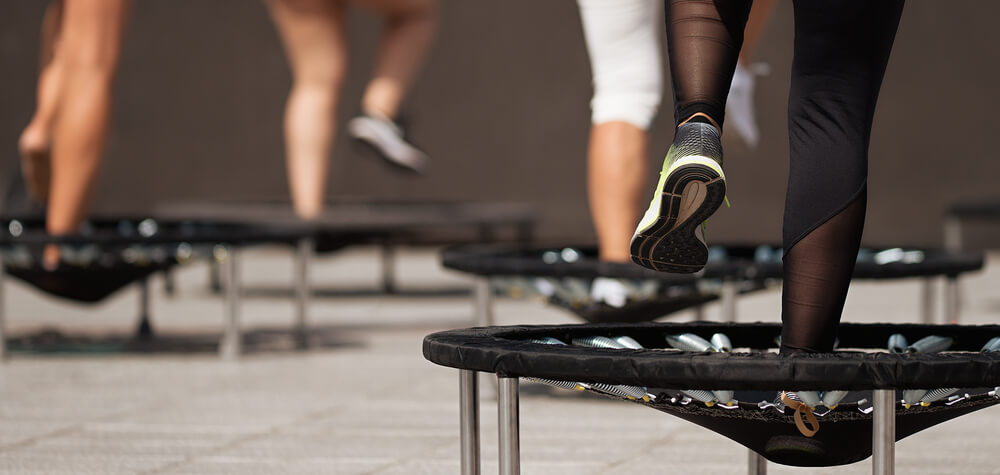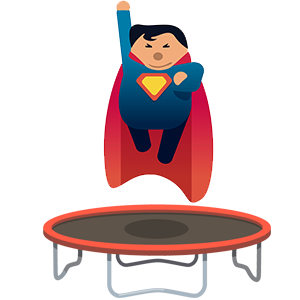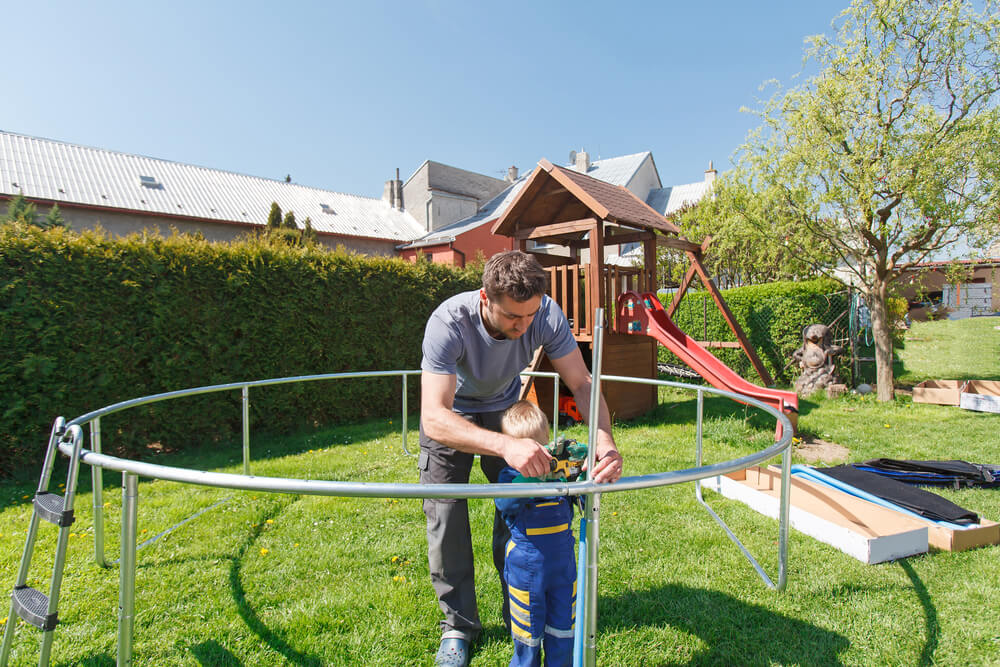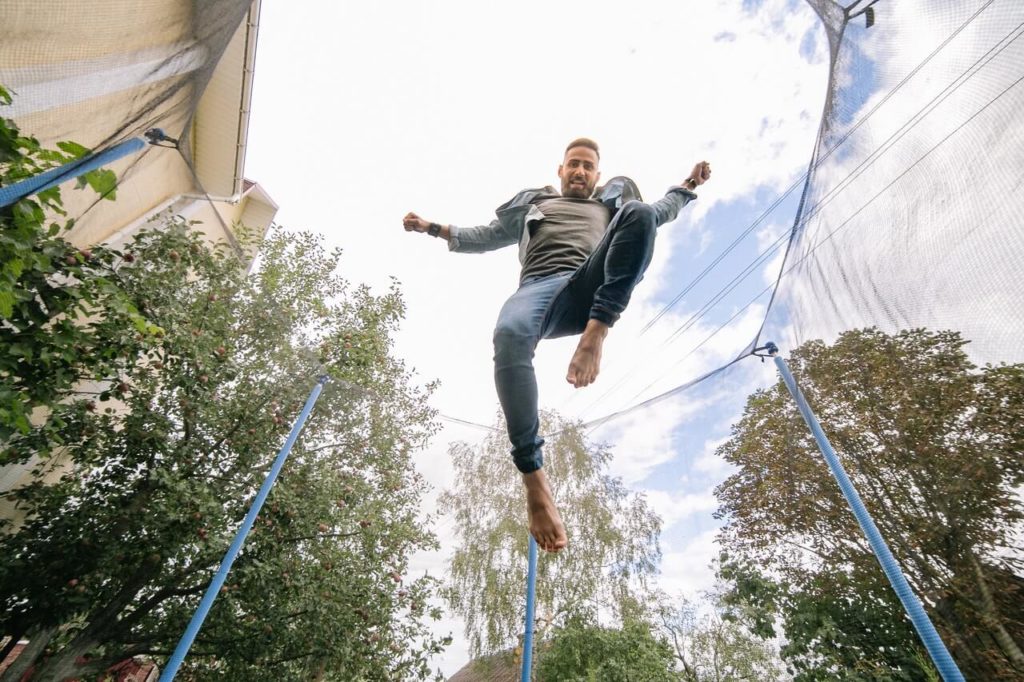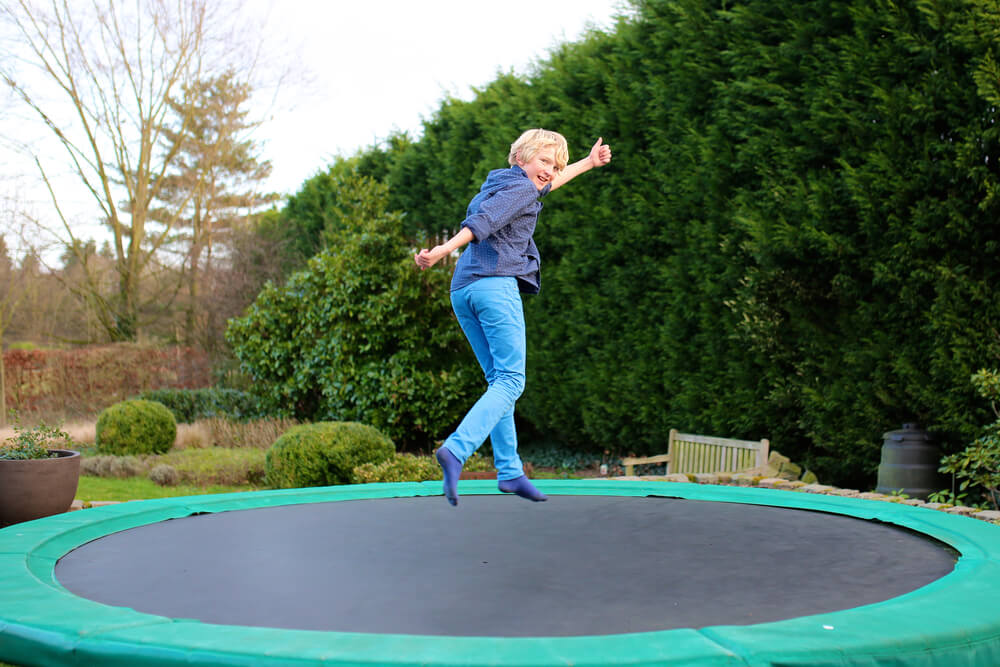Trampolining for a few minutes is all you need to keep fit. Read on to discover why rebounding beats running, the secret benefits of a trampoline exercise, and how to jump right.
Yes. It takes you only 10 – 15 minutes of trampoline jumping to achieve a whole mile of adrenaline rush. These few minutes pack a whole load of benefits, and you get to decide what’s best for your body.
Can trampolining replace your morning jog?
And what if you can’t run for long? Is bouncing on a trampoline a good alternative?
An ACE study observed that jumping on a trampoline is a great option for people looking for low exercise alternatives to running.
How so? Because it’s an exercise that engages the entire body without tiring the muscles and joints.
As it turns out, you can burn more calories trampolining than when jogging or running as we’ll find out later in the article.
But how many minutes of jumping on a trampoline equal a mile?
Big news: 10 minutes!
Didn’t think so? We’ll lift the veil for you.
A few minutes of rebounding in your backyard can work wonders than running.
Keep reading to find out how.
Comparing a Trampoline Mile with a Running Mile
Just so you know, it takes about 500 jumps on a trampoline to reach a mile. This makes trampoline jumping a quicker workout considering the 2,000 steps it takes to reach a mile while running.
Working out while enjoying every bit of the exercise is what differentiates trampolining from the rest. Aside from taking the least time to accomplish your goal, you can easily fix your schedule to spare a few minutes of bouncing on the trampoline.
Indeed, trampolining is an incomparable exercise. Imagine jumping for only 500 times to achieve a mile’s run! It is not only a fun exercise; it’s easier on the body too compared to the 2,000 steps you have to run in order to clock a mile.
Interesting, isn’t it?
While 500 jumps on a trampoline will take you under 10 minutes and still spare your muscles and joints, running a mile will take you up to 15 minutes with 2,000 steps and the exhaustion can be unbearable.
According to a NASA study, spending 10 minutes jumping on a trampoline is equivalent to a 30-minute run translated to a 2-mile run.
Why Trampolining is a Better Exercise
Stepping on a trampoline again probably reminds you of those exciting days when you were just a kid.
Taking it as an adult may be different, but the fun is the same. The first five minutes are disastrous, but that won’t stop you from going on and on until you get it. The longer you try, the bouncier it becomes and the more immersed in the fun you get.
- The American Council on Exercise says that working out on a mini trampoline gives you the same fitness benefits as running but with much less difficulty. Running can be tiresome.
It also needs a regular schedule and time to be effective. But rebounding will take you very little time with a lower impact on your joints and a myriad of benefits.
- Trampolining is a perfect home workout. It allows you to squeeze in a few minutes of your schedule with much success. Five to ten minutes of trampolining gets you sweating profusely, giving you the exhilaration that running can’t provide.
- Rebounding never feels like exercise. The adrenaline rush and the childlike thrill you get are pure joy. When you incorporate your bounces with music, time just flies. You can’t say the same about running. For trampolining, you can feel buzzing for hours on end without even realizing that you’re exercising.
- Unlike running, jumping on a trampoline is never affected by the weather. You can keep your mini trampoline indoors and continue exercising like you do every other day.
Benefits of Jumping on a Trampoline
By now, it should be evident to you that trampolining equals exercise, fitness, and fun. Your few minutes on a trampoline are worth lots of benefits after all.
Here’s what you get from trampolining.
1. Great for Cardio
Trampolining offers vigorous aerobic workouts that help to increase heart rate. It is also an excellent way of strengthening cardiovascular muscles.
2. Improves Bone Strength
Jumping on a trampoline strengthens your bones. By repetitively jumping on it, the bones are under very little stress, which encourages them to build up their mineral content. The density of the bones increases, minimizing the chances of developing such conditions as osteoporosis.
3. It is One of the Most Effective Ways of Exercising
You can never go wrong with rebounding if you do it well. The Nasa study points out clearly that spending your 10 minutes jumping on a trampoline is as good as taking a 30-minute run,
Do you know what this means?
That you get the same benefits in just a third of the time.
4. A good Stress Reliever and Mood Enhancer
With all the fun involved in trampolining, who wouldn’t let go of their stress and mood swings?
Aside from that, a good jump on your trampoline lets your body release endorphins – the feel-good chemicals found in the brain.
Endorphins, in turn, help in reducing anxiety, stress, and depression, leaving you with a feeling of invigoration.
5. Body Toning
While rebounding, many muscles are activated, including the leg, arm, and stomach muscles. This is because you have to utilize your core muscles in order to remain balanced.
Doing this regularly keeps your bottom and belly well toned.
But, wait there’s more! Jumping on a trampoline also:
6. Activates the Lymphatic System
The lymphatic system is responsible for carrying toxic waste out of the body. To work perfectly requires body movement and gravity.
An excellent trampoline bounce often stimulates the lymphatic drainage system to rid the body of toxins, waste, and bacteria from the cells and cleanse it.
7. Improves Coordination
To achieve maximum bounce on your trampoline, you need to be able to concentrate and balance.
Achieving different positions is only possible with focus, alert, and concentration too. You can’t prepare for the next position or move without proper thought coordination.
Rebounding is the most effective way of keeping your coordination in check. It improves your motor skills, helping you with coordination.
Can Jumping on a Trampoline Help You Lose Weight?
Yes, jumping on a trampoline can help to lose weight. While bouncing, you burn calories and boost your metabolism rate. These are core areas for fat burning.
As you bounce, more oxygen will flow through the body, increasing your energy levels.
Although it’s a low-impact workout, trampolining gets the heart pumping fast and works all muscles.
Trampolining the Right Way
Trampolining for the first time can be challenging, especially for an adult who’s never been on a trampoline or hasn’t used it for years. But if you do it the right way, the rest will be easy.
Want to know how to rebound?
Here’s how:
Start with a Warm-Up
Take time to warm up your muscles with easy jumps. This will get you used to the sensation of jumping. This isn’t the time to start jumping very high. A few inches upwards is okay at the beginning. With time the bounce will flow naturally.
Do Basic Jogs
A basic jog entails straightening your back or leaning slightly backward while lifting your knees in front, one at a time, and start jogging in place. Pump your arms at your sides, just like you do when running.
Carry On with Advanced Jogging
Now it’s time to move around on your trampoline on a broader stance. Jog on as you move your arms above your head. Keep jogging from one side to another to activate the different muscle groups in the body.
Proceed to Jumping Jacks
Performing jumping jacks on a rebounder is different from the usual. Here you’ll stomp down as you move your legs in and out. Make sure your torso is slightly bent forward, and your arms aren’t overhead.
Move your hands in and out to your sides while powering down with your legs. Continue with this motion for about two to three minutes.
Do a Pelvic Floor Bounce
Working your pelvic floor on a rebounder requires you to place a soft exercise ball between the knees. Then start bouncing slowly as you breathe into your pelvis.
As you breathe out, squeeze your inner thighs together and bounce for at least 5 minutes or less. Extend the time as you build your strength.
As time goes, you’ll start mastering rebounding. Just remember to alternate the exercises, add some intensity, time, and weights.
How Often Should You Jump on a Trampoline?
Right now, there aren’t any guidelines on the number of times you should rebound. However, according to a 2018 study, exercising on rebounders three days every week can deliver promising results.
How long you jump on your trampoline is up to you. But a 15 to 20 minutes jump is okay for any level jumper.
Take Away
The best thing about all this is the limitless exercise you can do on a rebounder, regardless of your age.
Now you have no excuse but to start planning how to get your mini trampoline and start rebounding right away.

